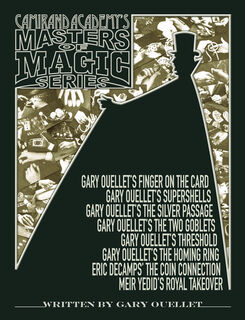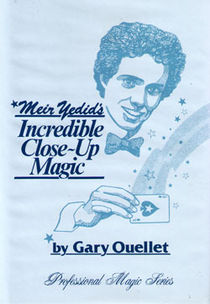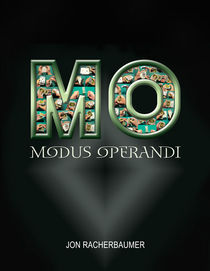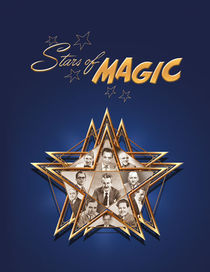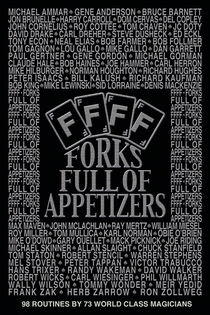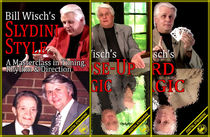Camirand Academy’s Masters Of Magic Series
 FREE U.S. SHIPPING
FREE U.S. SHIPPING
- Difficulty: INTERMEDIATE
- Category: CLOSE-UP MAGIC
- Product Type: BOOK
- FREE PDF Preview: HERE.
This is your chance to learn some classics of magic like a Ring On String routine, the Three Shell Game, Coins Through The Table, a Two Cup & Ball routine, a Torn & Restored Card, and much more magic and sleight of hand with cards and coins.
The Masters Of Magic Series was released between 1979-1986 and featured outstanding close-up routines. These were polished full routines that could be presented as theatrical pieces or used for informal close-up shows.
The booklets were published by the Camirand Academy of Magic and featured detailed writing by Gary Ouellet and a massive number of photographs by Guy Camirand making them very easy to learn from and to master.
Routines include:
►Finger On The Card: This is the card routine that launched the Camirand Academy. It is a sucker type effect where a card is selected. Two cards are used to identify its color and suit and one of them is placed under the spectator’s finger. The spectator is surprised that you did not know that the card under their finger is their selection. You then have them try to find their card in the deck. Amazingly the card they find is their selection which causes them to immediately check under their finger where a completely different card now resides.
►Supershells: Considered one of the best three shell game routines, that influenced many of the routines that professionals currently use. Includes many different phases, variations, and an impossible ending. You are also taught how to make your own shells.
►The Silver Passage: A coins through the table routine with some visual vanishes and penetrations and an added element of a small mirror which gets the credit for the coins melting through.
►The Two Goblets: Using two cups from a cups and balls combination set you perform a series of excellent and impossible looking sequences where a ball penetrates, vanishes, appears, and transposes. For the finale, three huge balls appear.
►Threshold: Although several different card routines and techniques are taught the main routine is a sit-down torn and restored card where the the double-signed card is torn into four pieces, one corner is held as a receipt, and the other pieces fuse together.
►The Homing Ring: A multiphase ring off rope routine where a finger ring repeatedly escapes after being tied to a rope and re-appears on your finger.
►Eric DeCamps’ The Coin Connection: A stand-up coin routine where three silver coins vanish to reappear in a purse. They then invisibly travel from hand to hand, converted into foreign coins, dropped back into the coin purse only to revert into their original silver coins.
►Meir Yedid’s Royal Takeover: A beautifully displayed routine where three cards are selected and found to be Aces. The three Aces visually change into a Royal Flush and everything is examinable.
The above routine descriptions are just the themes and main effects taught. Each section is full of variations, alternate phases, and many techniques. This book can act as a course in intermediate to advanced close-up magic.
First Edition. Written by Gary Ouellet. Published by Meir Yedid Magic in 2022. 8.75”x11.25” hardcover, with 272-pages, and more than 580-photographs. The hardcover edition is a limited edition of only 150 copies.
| Media Type | Shipped Product |
|---|
You might also like...
People who purchased this also purchased...
Customer Reviews
- 1 of 1 people found the following review helpful
A truly classic magic book focused on good technique with no extraneous B-material or fluff.
This review by Francis Menotti appeared in the May 2023 issue of Genii Magazine.
In an era when printed instructional material for magic is vastly overtaken by video instant downloads, it is sometimes easy to forget how well-written magic books were by necessity when they were (almost) the only option for learning. Camirand Academy’s Masters of Magic series first appeared in the late 1970s and early ’80s as a set of standalone, singly published professional routines.
Written by Gary Ouellet and produced with Guy Camirand, these detailed and extensively photograph-laden pamphlets sold for $12.50 each, even on their second edition printing in 1986. Now approaching 40 years later, the timeless material holds up both in quality and value--even accounting for inflation--in its hardbound compilation that Camirand and Meir Yedid have assembled. The new book in question, while since edited with corrections, updates, and bonus material, looks and feels like its ancestral origin. Yedid and Camirand elected to preserve the original style in typeset, font, and black-and- white photographs. This dresses the final product in nostalgia for those who may remember the original series while boldly and proudly presenting newer readers with a high-quality set of professional and time-tested material fit for most skill levels.
The book comprises eight sections: each a complete, performable routine. Each section is in order of its original publication and labeled as such, so the volume kicks off with Ouellet’s “Finger on the Card” manuscript in its 1985 reprinting. For those only familiar with its original 1979 release, Camirand writes in the intro that they fully rewrote it for its second edition and only the original photographs remained. The verbal and visual description of effect and method is incredibly clear and easy to follow, evidently with additional sequences and techniques not present in the first. It is a simple effect, easy enough for a relative beginner but well-structured enough that more experienced performers will get use and enjoyment from it. Essentially, a spectator selects and loses a card, then the magician uses two random cards from the deck to determine the color and suit of the selection. Of note, the transformed card payoff involves what could be considered a sucker effect if not for the suave and clever wording that does not dwell on the “gotcha” nature of such a piece. In his recommendations of scripting, Ouellet chastises against such belittling of the audience in what feels both retrospectively obvious and still ahead of his time. “I did not ask them if they had any friends, and made no comment on their clean (or filthy) hands.” Wise advice that seems still necessary to repeat constantly to this day.
Section Two is Ouellet’s “Super Shells,” a fully choreographed and refined Three Shell Game presentation that ends with the pea traveling from an impossibly isolated shell under a saucer under a bowl to the equally isolated shell under a glass. It’s a beautiful, clean, to the point routine that uses no fancy or special items. The authors advise using regular walnut shells, a self-carved foam rubber pea, and otherwise normal household paraphernalia to carry out the routine. Of amusing note is the introductory hard sell on giving the routine a chance. The publishers present the whiny what-ifs that might deter one from exploring the trick. Hesitations like “it’s too hard, there’s no punch, there’s no climax” are all addressed and dispelled with arguable ease. So much so that, while this reviewer has never even thought of messing with the Three Shell Game, I just might now.
The third section is titled “Silver Passage,” and takes the reader on a sort of portable hole meets coins-through-table journey using a mirror, four coins, and a wonderful DIY utility device that I’ll be making as soon as these words have been sent off to my editor. This, like a lot of the material in the book, is a bit heavy on lapping. The timing and thoughts behind all of the moves make it attainable for most moderately skilled coin workers.
The fourth section features Ouellette’s two-cup Cups and Balls routine, “The Two Goblets.” In line with the rest of the book’s material, it’s a multi-phase routine that employs useful sleights and beats that assure the success of the piece but can be carried over to one’s own Cups routine. “The Two Goblets” employs a regular Cups and Balls cup, a Chop Cup, shot glass, and silk.
Section five is titled “Threshold.” First published on its own in 1981, this features a number of small but powerful mini tricks including an easily overlooked or dismissed vanishing deck and other variations on this theme. “The Capricorn Card,” for example, features a single card selection being returned to the deck that then vanishes completely except for said selection. The namesake trick of this section is a Torn and Restored Card effect where both sides are signed and a number of simple but clever subtleties keep the audience sure that they’re seeing the same card the whole time.
Section six, “Homing Ring,” takes the reader through a pretty, multi-phase “Ring on Rope” sequence. As with the rest of the book, it is clear, compelling, and complete as a routine that the reader could learn and execute exactly as printed to great success.
The seventh section begins a new volume of the Masters of Magic series, this time featuring the bright young worker Eric DeCamps (published in 1986). In this chapter, DeCamps teaches his “Dazzling Close-Up Coin Act, The Coin Connection.” It is a brilliantly structured three-phase piece with a coin purse, expanded shell, half dollars, English pennies, and a sequence of efficient sleights, misdirection, and prop management. DeCamps makes strong argument for the coin purse over Okito Coin Boxes and the like for the same reasons that this reviewer has eschewed such boxes: they are strange foreign objects with which no normal humans are familiar. Phase one is “Homing Coins,” where the silver coins vanish singly and reappear inside the purse. Phase two is “Travel Agents,” an ergonomic tabled Coins Across sequence. Phase three, “Foreign Exchange,” closes out the routine with the transformation of all three silver coins into three copper ones and then back again, ending clean. Once again, this chapter stands alone as a full course in coin magic that can teach a great deal to beginners and experts alike.
To close out this newly reprinted collection of well-thought and well-taught classic magic, Meir Yedid offers a bonus section that teaches his “Royal Takeover.” Reprinted from his Incredible Close-Up Magic, it is a flashy transformation of three Aces into a royal flush. Featured in the handling is Yedid’s version of Herb Zarrow’s Revolving Force and Richard Kaufman’s Radical Change.
Guy Camirand and Meir Yedid compiled the commercial routines of Gary Ouellet, added a strong routine of Eric DeCamps, and a quick and pretty piece by Yedid into a truly classic magic book focused on good technique with no extraneous B-material or fluff. Its routines are deserving of study as good magical construction, well worthy of a spot on any worker’s shelf.
